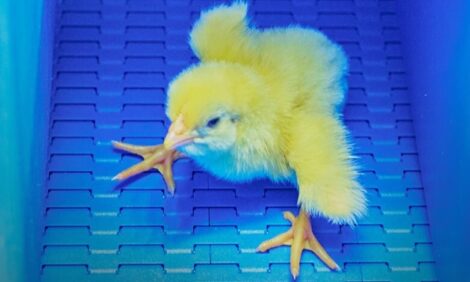



GLOBAL POULTRY TRENDS: Asia is Key to Global Egg Output Growth
Asia now accounts for almost 60 per cent of global hen egg production, according to poultry sector expert, Terry Evans, in his latest analysis of the world's egg industries. China dominates the league table within Asia, with a share of around two-thirds of the total output from the region.Global hen egg production will reach a new record of around 65.5 million tonnes in 2013, almost entirely as the result of continued growth in Asia. A one per cent cut-back in the US will impact on the total for the Americas, while lower production in the European Union - as a result of the introduction of the ban on cage production - will at least partly offset further growth in the rest of Europe.
The only official data on a global basis comes from the Food and Agriculture Organisation of the United Nations (FAO) the most recent data covering the period to 2010 (Table 1 and Figure 1).
During the decade to 2010, world hen egg output averaged 2.3 per cent a year, rising from 51 million tonnes to 63.8 million tonnes. Since 2010, the economic climate - in terms of both production costs and consumer purchasing power - has deteriorated, with the result that the annual expansion in egg production has slowed. Consequently, output in 2012 is assessed at around 65 million tonnes while for 2013, an increase of less than one per cent is anticipated, bringing the total to around 65.5 million tonnes.
It is clear from Table 1 and Figure 1 that global growth is closely linked to the development of Asia's egg industry. Note that the global totals include hatching eggs, which are estimated to represent around five per cent.

Back in 2000, Asia contributed some 29 million tonnes or almost 57 per cent of the global total of 51 million tonnes. By 2010, this region's share had risen to 58.6 per cent as production had climbed to 37.4 million tonnes out of a total of 63.8 million tonnes, and it looks as though in 2013 Asia will produce around 38.6 million tonnes of a world total of some 65.5 million tonnes, pushing its contribution up to 59 per cent.
In 2010, there were some 6,556 million layers worldwide, of which around 4,211 million (64 per cent) were in Asia.
Of the near 50 countries in this region, 10 produce more than 500,000 tonnes of eggs a year, their combined output of nearly 34.6 million tonnes representing 92.3 of the regional total in 2010 (Tables 2, 3 and 4). China's dominance in this picture is clear from these figures and Figure 2.
Output in China has escalated from just below 19 million tonnes in 2000 to almost 24 million tonnes in 2010, exhibiting an annual growth rate of 2.3 per cent. This was marginally slower than the 2.6 per cent recorded for the region as a whole hence, by the end of the decade, China's share of the total had slipped a shade from 65.2 per cent to 63.7 per cent. This observation is also true for the combined total of the 10 leading producing countries, their share having slipped from almost 94 per cent to 92.3 per cent, which serves to emphasise that considerable expansion has occurred among the other countries in Asia. Many managed to double their annual production, while their combined output increased by a million tonnes over the decade from 1.8 million tonnes to 2.9 million tonnes.
Although the quantity of fowl eggs produced in China exceeds 28 million tonnes a year, the volume of hen eggs amounts to around 24 million tonnes, the difference of more than four million tonnes being accounted for by other forms of poultry. The ratio of brown to white-shelled eggs is currently estimated at around 70:30, with 90 per cent of the commercial laying flock housed in cages. Like most producers, the Chinese are facing higher raw material costs but there are also concerns about labour shortages and the related rising labour charges. Consequently, near-future production growth could well be close to the one per cent recorded towards the end of the last decade.
India is easily the second largest egg producer in Asia, reporting a 5.2 per cent average annual increase over the years 2000 to 2010. Estimates of annual production vary, the most optimistic puts output in 2010 at 3.72 million tonnes, well above the FAO figure, with further growth of some 2.7 per cent in 2011 to 3.82 million tonnes. As always in these output calculations much depends on the average egg weight which, for India, some consider to be around 55g.
Large increases in feed prices in particular will have dampened expansion since then, while consumer prices have escalated by as much as 40 per cent, having an adverse impact on demand. Indeed, the industry has asked the government to impose a ban on maize exports to try and halt the escalation of corn prices. So, it looks as though any increase in production this year will be small compared to recent years. All the commercial flock is housed in cages, and more than 90 per cent of eggs are white-shelled.
Japan is the third largest egg producer. While annual production has shown some year-to-year fluctuation, it has hardly changed significantly throughout the past decade or so at around 2.5 million tonnes. The latest assessments indicate a small movement away from cages to barn production, with the latter currently accounting for some six per cent of all eggs against little more than one per cent a few years ago, according to data published by the International Egg Commission (IEC). The brown to white egg ratio is estimated at 39:61.
According to the FAO, Indonesia's egg industry expanded rapidly by nine per cent a year between 2000 and 2007 to peak at 1.18 million tonnes but it has since contracted somewhat.

During the first half of the decade covered by the FAO data, the egg industry in Iran also expanded quickly at more than 5.5 per cent a year to reach 758,000 tonnes in 2005. However, during the next five years, output has fluctuated somewhat and even failed to match the 2005 level in 2010. Furthermore, an outbreak of avian influenza has since brought about a severe contraction in production. All birds lay white eggs and are housed in cages.
Production in Turkey has varied around an average of some 800,000 tonnes a year although some sources consider that in 2010, this figure exceeded 900,000 tonnes. However, there are indications that output has since been cut to around 874,000 tonnes in 2011. Some two-thirds of the flock produce brown eggs, while virtually 100 per cent of output comes from cage units.
Although recording gains over the past decade, the average annual rate of expansion in both Thailand and Korea has been in the range of 1.3 to 1.8 per cent.
For the decade to 2010, the egg output in Pakistan expanded by about five per cent a year which, if it has been sustained, would put current production in excess of 600,000 tonnes.
Output in Malaysia showed a good 3.3 per cent expansion in the 10 years to 2010 to approach 550,000 tonnes by the end of the period.
February 2013












